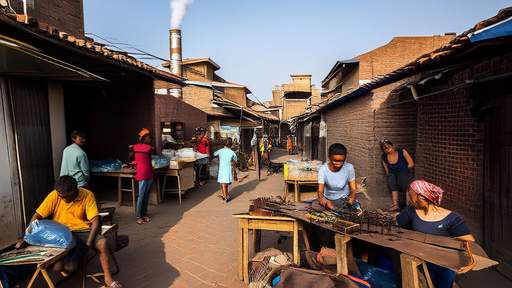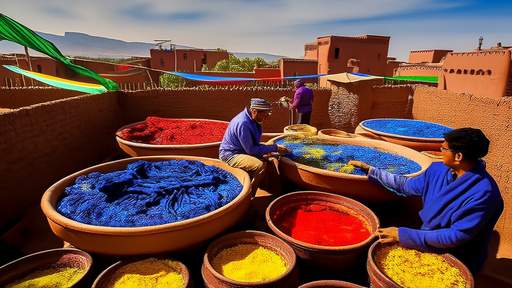The labyrinthine lanes of Dharavi, often labeled as Asia's largest slum, conceal an economic dynamism that defies its ramshackle appearance. Nestled in the heart of Mumbai, this 2.1-square-kilometer sprawl houses nearly a million residents and thrives as a microcosm of informal enterprise. While mainstream GDP metrics overlook such unregulated ecosystems, recent attempts to quantify Dharavi's economic output reveal a startling truth: its annual turnover rivals that of small nations. The story of Dharavi isn't one of poverty porn but of grassroots capitalism operating at hyperspeed.
Walk through the pottery quarter at dawn, and you'll witness artisans molding terracotta idols that supply temples across India. The leather district buzzes with workshops stitching bags for European high-street brands under subcontracts. Recyclers process 80% of Mumbai's plastic waste in a decentralized network more efficient than municipal systems. These industries aren't survival mechanisms but sophisticated supply chains with specialized labor pools. Anthropologist Jan Nijman's fieldwork estimates 15,000 single-room factories operate here, employing over 250,000 workers. When the BBC attempted to calculate Dharavi's GDP in 2010, they arrived at an astonishing $1 billion figure—a number that has likely doubled since.
The recycling sector alone presents a masterclass in circular economics. Over 5,000 kabadiwallas (waste pickers) form the first link in a value chain that transforms discarded PET bottles into polyester thread. Aluminum cans get smelted into ingots, while newspaper waste resurfaces as packaging material. This informal system achieves 95% material recovery rates, dwarfing Western recycling plants. Researcher Shekhar Vishwanathan's 2022 study found this vertical generates ₹3,800 crore ($450 million) annually, with profit margins exceeding 22%. Such efficiency stems from familial apprenticeship models where children learn metallurgy or plastic sorting as naturally as middle-class kids learn coding.
Dharavi's garment cluster exemplifies adaptive specialization. When global fast fashion brands demand 72-hour turnarounds, these micro-units deliver through a relay system. One alleyway handles buttonholes, the next specializes in hemming, while another focuses on screen-printing. This cellular production model allows for overnight order fulfillment that even Shenzhen factories would struggle to match. The Economic Times reported how a single order for 50,000 H&M tunics got distributed across 87 home units and was completed within 60 hours. With over $300 million in annual apparel exports, Dharavi's textile GDP per square foot outperforms Mumbai's Bandra Kurla financial district.
Food processing forms another economic pillar. The khari biscuit industry—flaky salted crackers unique to Mumbai—saturates national markets from Dharavi's communal ovens. Over 200 bakeries produce 4.5 million biscuits daily using century-old recipes adapted for mass production. Similarly, the pickling sector supplies 60% of India's hotel industry with preserved mangoes and limes. What fascinates economists is the self-regulated quality control. Since reputation sustains business in this tight-knit community, hygiene standards often surpass licensed facilities. Food scientist Dr. Meera Krishnan's microbial tests showed lower coliform counts in Dharavi's street-side papad (lentil wafer) units than in ISO-certified plants.
Real estate operates on its own calculus here. While official records show land values at ₹25,000/sq ft, the underground property market tells a different story. Multi-story hutments trade hands through pagdi systems—an unregistered leasehold tradition where tenants pay premiums up to ₹70 lakh ($84,000) for 150 sq ft spaces with no legal title. This shadow market's total value exceeds ₹40,000 crore ($4.8 billion), creating millionaire slumlords who reinvest in local businesses. Urban planner Rahul Mehrotra notes that Dharavi's density—270,000 people per square kilometer—generates economic velocity unmatched even in Manhattan.
The service sector thrives through hyper-local innovation. Jugaad (frugal innovation) manifests in enterprises like "cyber cafes" where illiterate workers use voice-assisted software to file government forms for clients. Medical diagnostic centers offer ultrasound scans for ₹150 ($1.80), using second-hand Japanese machines maintained through reverse engineering. Even the infamous "black water" tanker mafia—which illegally siphons municipal supplies—operates a $12 million annual business with subscription models and volume discounts. These parallel systems emerge where formal infrastructure fails, creating employment for thousands.
Attempts to quantify Dharavi's GDP face methodological hurdles. The Reserve Bank of India's 2021 pilot study applied satellite imagery and mobile payment trails to estimate economic activity. Their conservative figure of ₹1.2 lakh crore ($14.4 billion) would place Dharavi's economy between Montenegro and Barbados in global rankings. However, this excludes barter transactions—like tailoring services exchanged for dental work—that constitute 30% of local exchanges according to ethnographer Lina Fadel. The informal credit system alone circulates ₹500 crore ($60 million) monthly through blade companies—micro-finance operations so named for their razor-thin margins.
Globalization threads through Dharavi's economy in unexpected ways. During the UK's PPE crisis, 47 small units retooled to manufacture 3-ply masks, exporting 22 million units monthly. Afghan refugees run a thriving trade in saffron smuggling, leveraging Dharavi's distribution networks to bypass tariffs. Even the cryptocurrency boom found footing here, with backroom mining rigs powered by stolen electricity. Such adaptability makes Dharavi less a slum than a "startup city," argues economist Hernando de Soto, where human capital trumps physical capital.
As Mumbai's municipal corporation pushes redevelopment plans, economists warn against disrupting this organic ecosystem. The proposed high-rises could scatter industries reliant on proximity. MIT's Urban Economics Lab calculates that separating recycling units by just 800 meters would increase logistics costs by 37%, making operations unviable. Perhaps the real lesson from Dharavi isn't about measuring GDP but recognizing that economic complexity can flourish without—or even because of—the absence of formal governance. In these narrow alleys, capitalism has evolved its own distinct DNA.

By /Jun 5, 2025

By /Jun 5, 2025

By /Jun 5, 2025

By /Jun 5, 2025

By /Jun 5, 2025

By /Jun 5, 2025

By /Jun 5, 2025

By /Jun 5, 2025

By /Jun 5, 2025

By /Jun 5, 2025

By /Jun 5, 2025

By /Jun 5, 2025

By /Jun 5, 2025

By /Jun 5, 2025

By /Jun 5, 2025

By /Jun 5, 2025

By /Jun 5, 2025

By /Jun 5, 2025

By /Jun 5, 2025

By /Jun 5, 2025